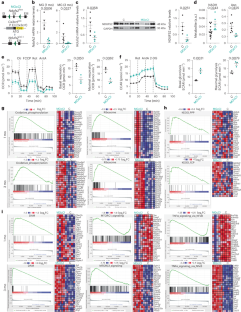Microglia mitochondrial complex I deficiency during development induces glial dysfunction and early lethality
IF 18.9
1区 医学
Q1 ENDOCRINOLOGY & METABOLISM
引用次数: 0
Abstract
Primary mitochondrial diseases (PMDs) are associated with pediatric neurological disorders and are traditionally related to oxidative phosphorylation system (OXPHOS) defects in neurons. Interestingly, both PMD mouse models and patients with PMD show gliosis, and pharmacological depletion of microglia, the innate immune cells of the brain, ameliorates multiple symptoms in a mouse model. Given that microglia activation correlates with the expression of OXPHOS genes, we studied whether OXPHOS deficits in microglia may contribute to PMDs. We first observed that the metabolic rewiring associated with microglia stimulation in vitro (via IL-33 or TAU treatment) was partially changed by complex I (CI) inhibition (via rotenone treatment). In vivo, we generated a mouse model deficient for CI activity in microglia (MGcCI). MGcCI microglia showed metabolic rewiring and gradual transcriptional activation, which led to hypertrophy and dysfunction in juvenile (1-month-old) and adult (3-month-old) stages, respectively. MGcCI mice presented widespread reactive astrocytes, a decrease of synaptic markers accompanied by an increased number of parvalbumin neurons, a behavioral deficit characterized by prolonged periods of immobility, loss of weight and premature death that was partially rescued by pharmacologic depletion of microglia. Our data demonstrate that microglia development depends on mitochondrial CI and suggest a direct microglial contribution to PMDs. Microglia rely on mitochondrial complex I during development, suggesting that complex I deficiency in microglia may have a role in primary mitochondrial diseases.


小胶质细胞线粒体复合体 I 在发育过程中的缺乏会诱发胶质细胞功能障碍和早期致死率
原发性线粒体疾病(PMDs)与小儿神经系统疾病有关,传统上与神经元的氧化磷酸化系统(OXPHOS)缺陷有关。有趣的是,PMD 小鼠模型和 PMD 患者都会出现神经胶质增生,而药理消耗小胶质细胞(大脑的先天免疫细胞)可改善小鼠模型的多种症状。鉴于小胶质细胞的激活与 OXPHOS 基因的表达相关,我们研究了小胶质细胞的 OXPHOS 缺陷是否可能导致 PMD。我们首先观察到,体外小胶质细胞刺激(通过 IL-33 或 TAU 处理)引起的代谢重新布线会因复合体 I(CI)抑制(通过鱼藤酮处理)而部分改变。在体内,我们生成了一种小胶质细胞中 CI 活性缺失的小鼠模型(MGcCI)。MGcCI 小胶质细胞表现出新陈代谢的重新布线和逐渐的转录激活,这分别导致了幼年期(1 个月大)和成年期(3 个月大)的肥大和功能障碍。MGcCI 小鼠表现出广泛的反应性星形胶质细胞、突触标记物的减少以及蛛网膜旁神经元数量的增加,其行为缺陷的特点是长时间不动、体重减轻和过早死亡。我们的数据证明,小胶质细胞的发育依赖于线粒体 CI,并表明小胶质细胞对 PMDs 有直接贡献。
本文章由计算机程序翻译,如有差异,请以英文原文为准。
求助全文
约1分钟内获得全文
求助全文
来源期刊

Nature metabolism
ENDOCRINOLOGY & METABOLISM-
CiteScore
27.50
自引率
2.40%
发文量
170
期刊介绍:
Nature Metabolism is a peer-reviewed scientific journal that covers a broad range of topics in metabolism research. It aims to advance the understanding of metabolic and homeostatic processes at a cellular and physiological level. The journal publishes research from various fields, including fundamental cell biology, basic biomedical and translational research, and integrative physiology. It focuses on how cellular metabolism affects cellular function, the physiology and homeostasis of organs and tissues, and the regulation of organismal energy homeostasis. It also investigates the molecular pathophysiology of metabolic diseases such as diabetes and obesity, as well as their treatment. Nature Metabolism follows the standards of other Nature-branded journals, with a dedicated team of professional editors, rigorous peer-review process, high standards of copy-editing and production, swift publication, and editorial independence. The journal has a high impact factor, has a certain influence in the international area, and is deeply concerned and cited by the majority of scholars.
 求助内容:
求助内容: 应助结果提醒方式:
应助结果提醒方式:


